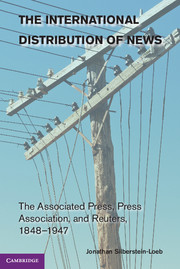 The International Distribution of News
The International Distribution of News Book contents
- Frontmatter
- Dedication
- Contents
- List of Tables
- Acknowledgments
- 1 Introduction
- 2 Conceiving Cooperation among American Newspapers, 1848–1892
- 3 Cooperation, Competition, and Regulation in the United States, 1893–1945
- 4 The “Rationalist Illusion,” the Post Office, and the Press, 1868–1913
- 5 Private Enterprise, Public Monopoly, and the Preservation of Cooperation in Britain, 1914–1941
- 6 Reluctant Imperialist? Reuters in the British Empire, 1851–1947
- 7 Cartel or Free Trade: Supplying the World’s News, 1856–1947
- 8 Conclusion
- Bibliography
- Index
- References
3 - Cooperation, Competition, and Regulation in the United States, 1893–1945
Published online by Cambridge University Press: 05 July 2014
- Frontmatter
- Dedication
- Contents
- List of Tables
- Acknowledgments
- 1 Introduction
- 2 Conceiving Cooperation among American Newspapers, 1848–1892
- 3 Cooperation, Competition, and Regulation in the United States, 1893–1945
- 4 The “Rationalist Illusion,” the Post Office, and the Press, 1868–1913
- 5 Private Enterprise, Public Monopoly, and the Preservation of Cooperation in Britain, 1914–1941
- 6 Reluctant Imperialist? Reuters in the British Empire, 1851–1947
- 7 Cartel or Free Trade: Supplying the World’s News, 1856–1947
- 8 Conclusion
- Bibliography
- Index
- References
Summary
Although the increase in competition that telegraphy generated during the 1840s encouraged newspapers to cooperate, the limited reach of the nascent communications network, and the consequent costs of coordination among a large group of publishers, kept participation in these early news organizations small, personal, and regional. Limited telegraph bandwidth, and then opportunistic behavior, prevented the loose federation of news associations that emerged after the Civil War from establishing a comprehensive nationwide organization. Yet, by 1897, the operations of the Associated Press not only encompassed the territory from the East Coast to the West, it had eliminated potential rivals and consolidated its control over the newsgathering business of the country. The path to the establishment of a nationwide news association lay not through merger or horizontal integration, but through the maintenance of exclusivity and the elimination of competitors.
The Formation and Ascendance of the AP
Following disagreeable revelations about the secret agreements between the WAP and UPA, Lawson and several Midwestern publishers fulminated a rearrangement of relations that would better serve their interests and protect their exclusive franchises. Their efforts culminated in December 1892 with the incorporation of the AP in Chicago, which that year surpassed Philadelphia as the second largest city in the United States. The AP charter entitled the association to not only to “buy, gather and accumulate information and news; to vend, supply, distribute and publish the same,” but also “to purchase, erect, lease operate, and sell telegraph and telephone lines and other means of transmitting news; to publish periodicals; to make and deal in periodicals.” The AP reserved the right to erect and operate telegraphs for fear that relations with Western Union might sour or that Western Union might either raise its rates or enter the news business. In other respects, the new association was much the same as the WAP, save that Lawson was in charge. Initially, Lawson and his friends contemplated the continuance of an integrated two-firm solution, believing that closer cooperation between Chicago and New York might advantageously stifle competition from hostile third parties. During the winter of 1892–1893, Lawson drew up the bylaws of the AP in conjunction with executives of the UPA.
- Type
- Chapter
- Information
- The International Distribution of NewsThe Associated Press, Press Association, and Reuters, 1848–1947, pp. 46 - 87Publisher: Cambridge University PressPrint publication year: 2014


